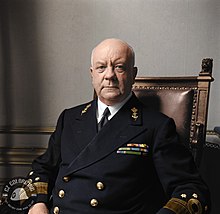Conrad Helfrich
Conrad Emil Lambert Helfrich | |
|---|---|
 Helfrich in 1946 | |
| Nickname(s) | Ship a day Helfrich |
| Born | 11 October 1886 Semarang, Dutch East Indies |
| Died | 20 September 1962 (aged 75) The Hague, Netherlands |
| Allegiance | Netherlands |
| Service | Royal Netherlands Navy |
| Years of service | 1903–1948 |
| Rank | Lieutenant admiral |
| Commands | ABDAFLOAT |
| Battles / wars | |
| Awards | Knight Grand Cross of the Order of the Netherlands Lion Commander of the Order of Orange-Nassau Knight Commander of the Order of the Bath (United Kingdom) Silver Cross of the Virtuti Militari (Poland) |
| Signature | |
Lieutenant Admiral Conrad Emil Lambert Helfrich (11 October 1886 – 20 September 1962) of the Royal Netherlands Navy was a leading Dutch naval figure of World War II. He was born in Semarang.
World War II
[edit]Helfrich was appointed overall commander of all forces in the Netherlands East Indies in October 1939.[1] At the outbreak of the war in the Pacific he gave instructions to wage war aggressively. His small force of submarines sank more Japanese ships in the first weeks of the war than the entire British and US navies together, an exploit which earned him the nickname "Ship-a-day Helfrich".[2] Admiral Helfrich worked tirelessly to establish co-operation with the Allied navies in the area since he knew that the Dutch could not hope to protect the Dutch East Indies by themselves.
Java Sea
[edit]When a combined command (ABDA) was finally created in January 1942, he was bypassed for the post of commander of the navy, in favour of Admiral Thomas C. Hart of the United States Navy. Helfrich's mission to defend Java at all costs clashed with Hart's desire to conserve as many naval units as possible. On 12 February 1942, Helfrich succeeded Hart as commander of the American–British–Dutch–Australian naval forces in the Pacific and immediately went on the offensive.[2] Unfortunately, the courage of the "Striking Force" was to no avail in the face of the overwhelming superiority of the Japanese navy and after the disastrous Battle of the Java Sea, most of the ABDA ships under his command had been put out of action and ABDA itself was dismantled. Helfrich spent the remainder of the war in Ceylon preparing the return of Dutch administration to the Dutch East Indies.
Japanese surrender
[edit]
In 1945, he was given command of all Dutch naval forces and promoted to lieutenant admiral. On 2 September 1945, he signed the Japanese Instrument of Surrender aboard the battleship USS Missouri on behalf of the Kingdom of the Netherlands.[1]
Helfrich returned to the Dutch East Indies on 1 October 1945, where he commanded the Dutch forces in the Dutch East Indies until 24 January 1946 when the post of commander of the armed forces in the East was abolished. During that time, Commander Helfrich had to deal with the Indonesian struggle for independence. He was a fierce opponent of compromising with Sukarno and, supported by Chief of the General Staff Hendrik Johan Kruls, he objected to the Linggarjati Agreement of 15 December 1946, but without effect.
He remained in command until his retirement from the navy on 1 January 1949.[1]
He wrote his memoirs which were published in 1950 and he died in The Hague, on 20 September 1962.[1]
Honours and awards
[edit]For his services during the World War, Helfrich received several awards. He was Commander of the Order of Orange-Nassau with Swords, Knight Grand Cross of the Order of the Netherlands Lion, Honorary Knight Commander of the Order of the Bath (UK) and awarded the Silver Cross (5th grade) of the Virtuti Militari (Poland). He had also received the Expedition Cross.
Notes
[edit]- ^ a b c d Klemen, L (1999–2000). "Vice-Admiral Conrad Emil Lambert Helfrich". Forgotten Campaign: The Dutch East Indies Campaign 1941–1942. Archived from the original on 26 July 2011.
- ^ a b "World Battlefronts: Dutchman's Chance". Time. 23 February 1942. Archived from the original on 7 March 2008.
References
[edit]- L, Klemen (2000). "Forgotten Campaign: The Dutch East Indies Campaign 1941–1942".
External links
[edit]- [1]
- "World Battlefronts: Home Is The Sailor". Time. March 9, 1942.
- 1886 births
- 1962 deaths
- People from Semarang
- Royal Netherlands Navy admirals
- Admirals of World War II
- Commanders of the Royal Netherlands Navy
- Royal Netherlands Navy personnel of World War II
- Commanders of the Order of Orange-Nassau
- Honorary Knights Commander of the Order of the Bath
- Recipients of the Silver Cross of the Virtuti Militari
- Dutch military personnel of the Indonesian National Revolution
- Dutch people of the Dutch East Indies
